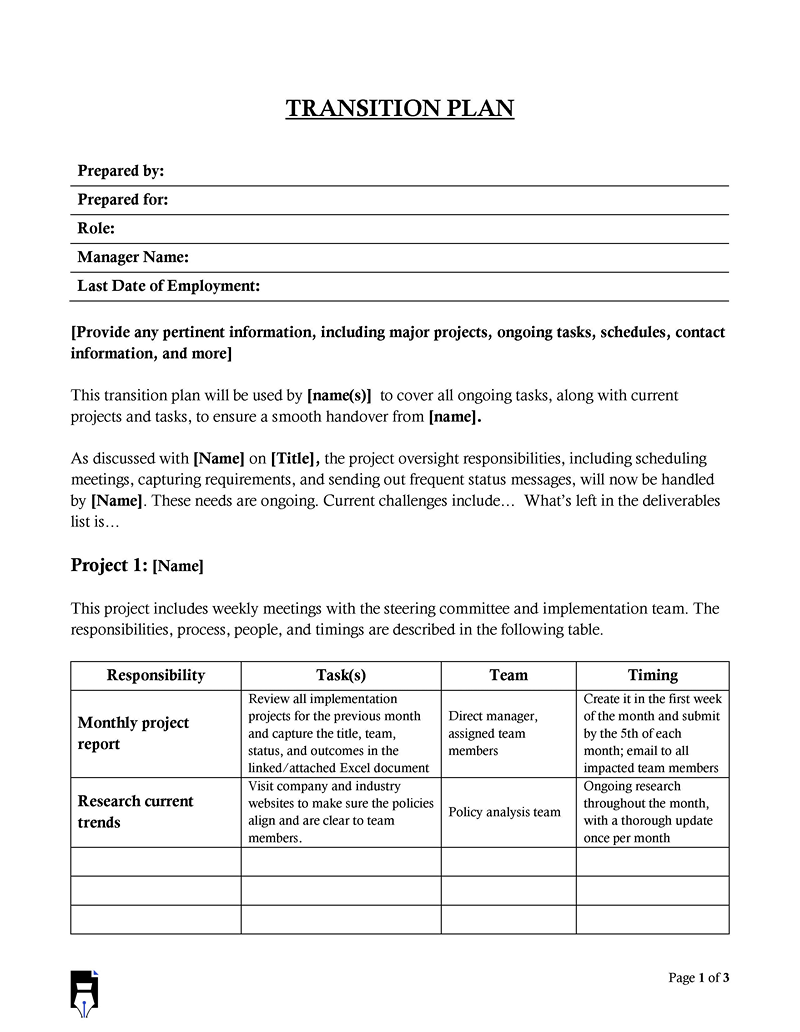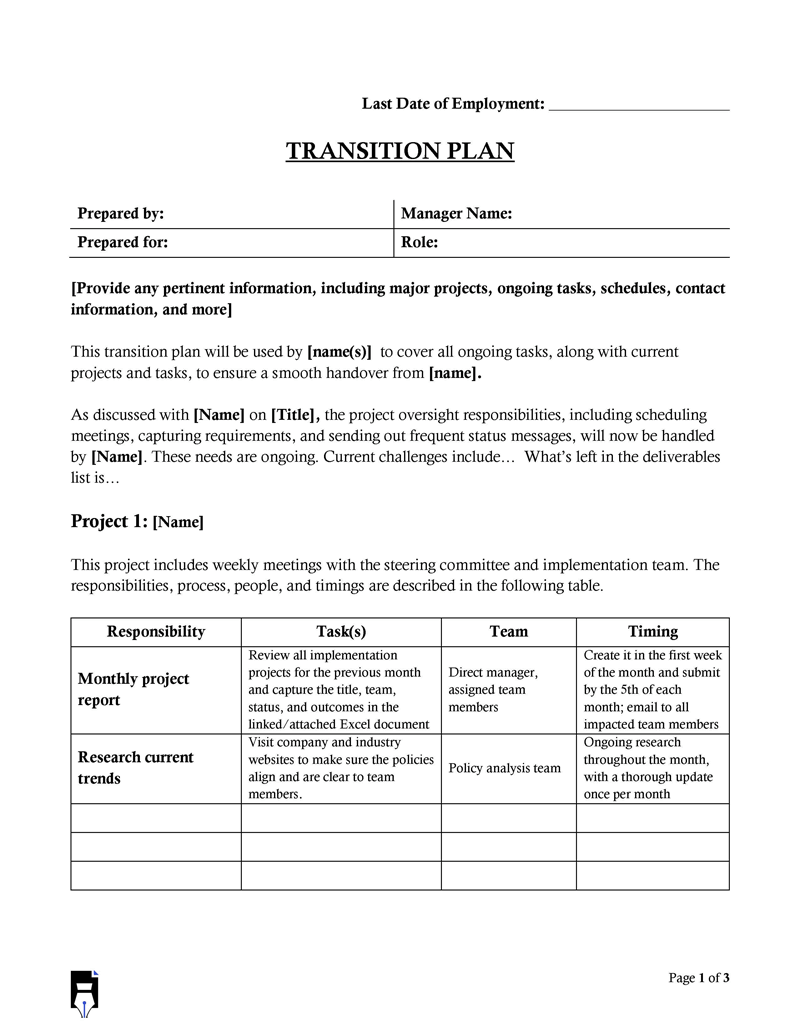Employees’ transitions impact the dynamics of an organization, as they are common and challenging. Navigating these shifts necessitates a proper plan that, if not handled correctly, often results in poor performance. Whenever an employee shifts to another position or departs the organization, any tasks they were involved with must continue properly. Therefore, transferring valuable knowledge and duties before an employee departs is critical to keep key projects moving.
A transition plan template helps to outline all of the activities and processes involved with the shift from the existing employee to a successor within an organization. It provides appropriate guidance and establishes specific steps that must be taken to facilitate the change. It outlines a supervisor’s duties and responsibilities when an employee moves from a role or leaves the organization entirely.
It can, however, be utilized for a project transfer, training new employees, or when a business owner becomes a buyer. These plans vary from one organization, project, or role to another. The basic structure, however, remains the same.
An organization experiencing significant changes, such as mergers, acquisitions, or downsizing, uses a transition plan. It assists employees impacted by the change to seamlessly shift into new organizations or positions. To ensure that the switch is beneficial, the plan should be designed to benefit both the employee and the organization.
This article will discuss the significance of a plan for your changing employee and what to include in one. Templates have also been provided for your convenience, especially if you have more than one employee switching. Instead of starting from scratch each time, you must draft a transition plan. You may download and customize one of our templates. These provide a blueprint for the duties and information employees must transfer before departing.
Transition Plan Templates
You can download the following templates for free:
The Impact of a Transition Plan on Your Business
It is inappropriate to pick someone and place them in a position until you properly plan for the change. A transition plan assists organizations in ensuring the continuity of a position’s responsibilities by establishing a standard operating procedure (SOP).
Whether the organizational change is by design or not, it ensures that all responsibilities are documented to ensure a smooth shift. It brings all the goals, strategies, and priorities for a seamless switch together in one place.
A transition plan functions as a handbook for the successor. It also reduces the risk of compromising business relationships if the job involves interacting with clients or vendors. A well-executed plan minimizes stress and anxiety for an employee resulting from the change. As a result, they will welcome the change positively if the necessary support and resources are provided.
An organization can retain key personnel if they feel valued and supported during a change. If the transition is coherent, an organization can continue with its day-to-day operations with minimal disruptions that may affect key stakeholders. An organization can use a template to reduce project risk by ensuring a strategy is in place before an emergency occurs.
Anatomy of Transition Plan: What You Need to Include
A transition plan is a framework that assists your organization in transferring duties from the departing employee to a successor. However, when transferring a significant amount of responsibilities, being organized is very vital.
As a result, you will need to develop a template to help you sort the responsibilities that need to be transferred. These should be categorized based on factors such as timeframe and priority.
When formatting it, ensure its structure includes the following:
- A list-view grid that displays all of the relevant tasks at once, allowing you to see not only due dates and task titles but also any relevant custom fields such as progress, priority, and deadlines.
- Unique custom fields illustrate and monitor the status of tasks, making it simple to determine which ones take precedence.
- Subtasks to divide and distribute work into individual components. This is also beneficial when there are multiple contributors to a task.
A transition plan typically includes the following key elements:
Duties and responsibilities
These are the tasks and obligations that have a significant impact on the processes of your organization. To identify these duties prudently, determine which team member is best suited to perform a task without jeopardizing other projects. The responsibilities should be sufficiently detailed, from a simple task such as reporting sales to a more intricate task of preparing a financial report.
Recurring duties, such as updating the company dashboard, should also be detailed. Organizing and classifying the responsibilities based on their timeframe and priority is vital. Finally, links to relevant documentation should be included to provide sufficient context and necessary information.
Duties and responsibilities in a transition plan may be presented in the template in the format shown below:
Core Duties and Responsibilities
Daily
-Responsibility 1
-Responsibility 2
[Link to File Path]
Monthly
-Responsibility 1
-Responsibility 2
[Link to File Path]
Annually
-Responsibility 1
-Responsibility 2
[Link to File Path]
Outstanding projects
This section of the template contains a list of current projects, including those that your employee will finalize before departing and how long it will take. Each project should have its own section that includes a , timeframes, progress, a proposed list of project owners, steps required to complete them, and directions for retrieving relevant files.
You may also leave a field for your departing employee to leave instructions to assist their successor with the projects and ensure they run smoothly after the change.
Outstanding projects in a transition plan may be presented in the format shown below:
Outstanding Projects
Project Name: __________________
Project Description: __________________
Status: __________________
Team Roster: 1. ________________
2. ________________
Relevant Deadlines: __________________
Project Files: [Link to File Path]
Upcoming deadlines
These responsibilities do not have a definite deadline and can include routine tasks. For example, there may be a deadline to order raw materials or file taxes with the government. This section differs significantly from the outstanding project section since it deals with standalone deadlines. The manner of deadlines and due dates are listed in this section.
The upcoming deadlines can be presented on the template in the format shown below:
Upcoming Deadlines
-Deadline 1: [Date], [Brief Description], [Instructions]
-Deadline 2: [Date], [Brief Description], [Instructions]
Key contacts
To ensure that ongoing projects progress smoothly, the new employee must know whom to contact, how, and why. This list includes the names, phone numbers, email addresses, and physical addresses of individuals linked to specific projects or that are a part of your organization. It may also contain login information for important accounts and resources. This list makes navigating certain aspects of the job simpler for the successor.
Key contacts in a transition plan may be presented in the template in the format shown below:
Key Contacts
Name: _________________
Title: _________________
Organization: _________________
Contact Information: [Physical Address]
[Phone Number]
[Email Address]
Description of Collaboration: _________________
Note: Creating a transition plan and remembering to include all the information listed above may be time-consuming and challenging. To help you prepare a document that will make the switch seamless, download one of our free templates and customize it to your specific needs.
Final Words
When your employee departs from their position, a transition plan is required to guarantee the continuity of your operations. It specifies the tasks, including responsibilities and duties of the departing employee, that must be completed for your operations to run smoothly. A template can provide the necessary framework to draft it. Remember that your plan outlines a systematic process that should be implemented immediately rather than filed away for later evaluation.
For your transitioning employee, the idea of change can seem challenging, but with a proper plan, it becomes more tolerable and likely to succeed. During the shifting process, engage with the new employee and ask them how they would like to grow. This type of involvement allows you to understand the talents and abilities that may not be utilized to their full potential and bring them to their new position.

